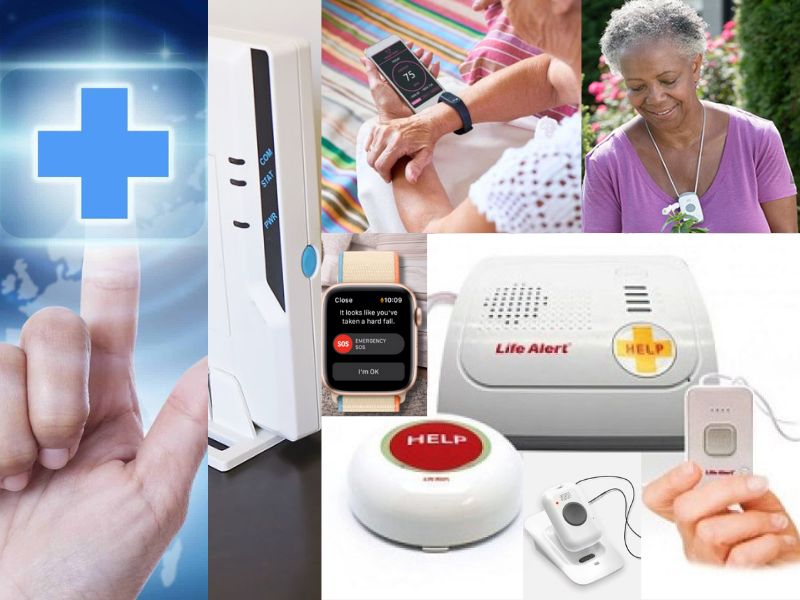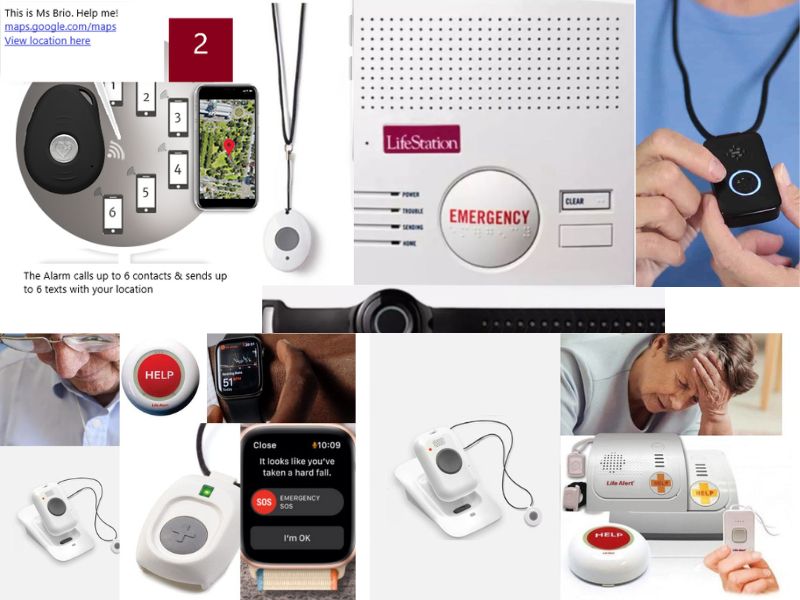Types of Medical Alert Systems and How They Work
There are various types of medical alert systems available on the market, and understanding the features and benefits of each type is crucial in selecting the most suitable system for your needs.

Home-based medical alert systems use a base unit and a wearable device to call for help in case of an emergency, and they connect to a monitoring center through a landline or cellular connection.
Mobile medical alert systems are portable and use cellular or GPS technology to track the user’s location and call for help when needed.
The best medical alert systems with fall detection for seniors can automatically detect falls and notify the monitoring center, while two-way communication medical alert systems allow for verbal communication with a call center operator. There are also voice-activated, wearable, in-home monitoring, and Wi-Fi-enabled medical alert systems available, each with unique features to meet different needs.
Medical alert systems have become increasingly popular, especially among seniors who live independently or have medical conditions requiring constant monitoring. These systems are designed to provide quick and easy access to medical assistance in an emergency. This article will discuss the various types of medical alert systems available in the market and how they work.
Types of Medical Alert Systems
In-home Medical Alert Systems
As the name suggests, in-home medical alert systems are designed to work within the confines of your home. These systems come with a base station connecting to your landline or cellular network and one or more wearable devices you can activate in an emergency. The wearable device is usually a pendant or a wristband that you can wear around your neck or wrist. When you activate it, the device sends a signal to the base station, alerting a monitoring center or a pre-programmed emergency contact.
Mobile Medical Alert Systems
Mobile medical alert systems, or GPS medical alert systems, are designed to work indoors and outdoors. These systems have wearable devices with GPS capabilities and can connect to a cellular network. This device can be worn around your neck or wrist and can be activated in the event of an emergency. When you activate the device, it sends your location to a monitoring center or a pre-programmed emergency contact, who can dispatch assistance to your location.
Fall Detection Medical Alert Systems

Fall detection medical alert systems are designed to automatically detect falls and send an alert to a monitoring center or a pre-programmed emergency contact. These systems come with wearable devices with sensors that can detect sudden movements or changes in orientation.
If the device detects a fall, it sends an alert to the monitoring center, which can dispatch assistance to your location.
How Medical Alert Systems Work
Medical alert systems connect you to a monitoring center or a pre-programmed emergency contact in the event of an emergency. When you activate the wearable device, it sends a signal to the base station or a cellular network, sending an alert to the monitoring center or the emergency contact.
The monitoring center or the emergency contact will then attempt to contact you through the base station or the cellular network. If they are unable to reach you or if you confirm that you need assistance, they will dispatch emergency services to your location.
Key Features of Medical Alert Systems
Medical alert systems allow seniors, people with disabilities, or those with medical conditions to call for help in an emergency. Here are some key features of medical alert systems:
- Emergency response: The primary function of a medical alert system is to provide immediate assistance during an emergency. When the user presses the help button, the system alerts a monitoring center, dispatching emergency services or contacting designated family members or caregivers.
- Help button: Most medical alert systems have a wearable help button that can be worn around the neck, wrist, or waist. This button is designed to be easily accessible in case of an emergency.
- Two-way communication: Medical alert systems usually feature two-way communication, which allows the user to communicate with the monitoring center in case they cannot speak or hear.
- Fall detection: Some medical alert systems use fall detection technology to detect falls and trigger an emergency response automatically.
- GPS tracking: Some medical alert systems come with GPS tracking, which can help locate the user in an emergency, especially if they cannot provide their location.
- Battery life: Medical alert systems typically come with rechargeable batteries that last between 24 and 72 hours, depending on the model and usage.
- Waterproof: Since accidents can happen anywhere, medical alert systems are designed to be waterproof, allowing the user to wear them in the shower or while swimming.
- Cost: Depending on the features and services offered, medical alert systems can vary in price. Some systems require a monthly subscription fee, while others may charge an upfront fee or offer a one-time payment option.
Pros and Cons of Medical Alert Systems
Medical alert systems can provide peace of mind for the user and their loved ones, but like any technology, they have pros and cons. Here are some of the most significant advantages and disadvantages of medical alert systems:
Pros:
- Increased safety and independence: Medical alert systems allow seniors and people with medical conditions to live independently while providing access to immediate assistance in case of an emergency.
- Quick response times: The monitoring center can dispatch emergency services or contact designated caregivers within seconds of receiving a distress signal, ensuring that the user receives prompt assistance.
- Fall detection technology: Some medical alert systems feature fall detection technology, which can detect falls and automatically notify the monitoring center, even if the user cannot press the help button.
- Peace of mind: Knowing that help is always available can provide peace of mind for the user and their loved ones.
Cons:
- Cost: Medical alert systems can be expensive, especially if users require additional features such as fall detection or GPS tracking.
- False alarms: Medical alert systems can sometimes trigger false alarms, which is frustrating for both the user and the monitoring center.
- Limited range: Some medical alert systems have a limited range, which can be problematic if the user needs assistance outside their home.
- Dependence on technology: Medical alert systems depend on technology and can be ineffective during a power outage or other technological issues.
FAQs
Does insurance cover medical alert systems?
It depends on your insurance provider. Some insurance providers may cover the cost of a medical alert system, while others may not. It’s important to check with your insurance provider to see if they offer coverage for medical alert systems.
Can medical alert systems be used outside the home?
Yes, mobile medical alert systems are available in the market that can be used indoors and outdoors.
What happens if I activate my medical alert system by mistake?
If you activate your medical alert system by mistake, you should immediately notify the monitoring center or the emergency contact and inform them that it was a false alarm.
Conclusion

Medical alert systems are an important tool for seniors and people with medical conditions that require constant monitoring. Various medical alert systems are available in the market, including in-home, mobile, and fall detection systems.
Each system has advantages and disadvantages; choosing the right one is important.
